感官动词系动词定稿版
- 格式:docx
- 大小:213.87 KB
- 文档页数:6
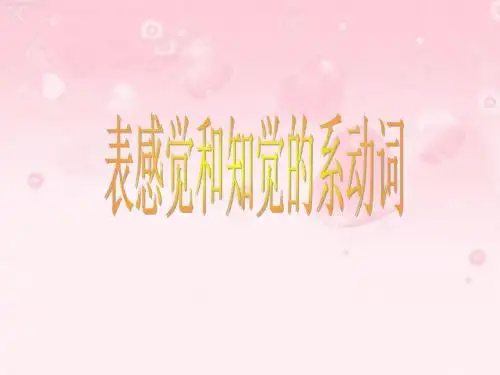

(完整版)初中英语感官动词的用法编辑整理:尊敬的读者朋友们:这里是精品文档编辑中心,本文档内容是由我和我的同事精心编辑整理后发布的,发布之前我们对文中内容进行仔细校对,但是难免会有疏漏的地方,但是任然希望((完整版)初中英语感官动词的用法)的内容能够给您的工作和学习带来便利。
同时也真诚的希望收到您的建议和反馈,这将是我们进步的源泉,前进的动力。
本文可编辑可修改,如果觉得对您有帮助请收藏以便随时查阅,最后祝您生活愉快业绩进步,以下为(完整版)初中英语感官动词的用法的全部内容。
(完整版)初中英语感官动词的用法编辑整理:张嬗雒老师尊敬的读者朋友们:这里是精品文档编辑中心,本文档内容是由我和我的同事精心编辑整理后发布到文库,发布之前我们对文中内容进行仔细校对,但是难免会有疏漏的地方,但是我们任然希望(完整版)初中英语感官动词的用法这篇文档能够给您的工作和学习带来便利。
同时我们也真诚的希望收到您的建议和反馈到下面的留言区,这将是我们进步的源泉,前进的动力.本文可编辑可修改,如果觉得对您有帮助请下载收藏以便随时查阅,最后祝您生活愉快业绩进步,以下为〈(完整版)初中英语感官动词的用法〉这篇文档的全部内容。
初中英语感官动词的用法一、感官动词1、感官动词(及物动词)有:see/notice/look at/watch/observe/listento/hear/feel(Vt)/taste(Vt)/smell(Vt)2、连缀动词(含感官不及物动词) :be/get/become/feel/look/sound/smell/taste/keep/stay/seem/appear/grow/turn/prove/remain/go/run二、具体用法:1、see, hear, smell, taste, feel,这五个动词均可作连系动词,后面接形容词作表语,说明主语所处的状态。
其意思分别为”看/听/闻/尝/摸起来……"。
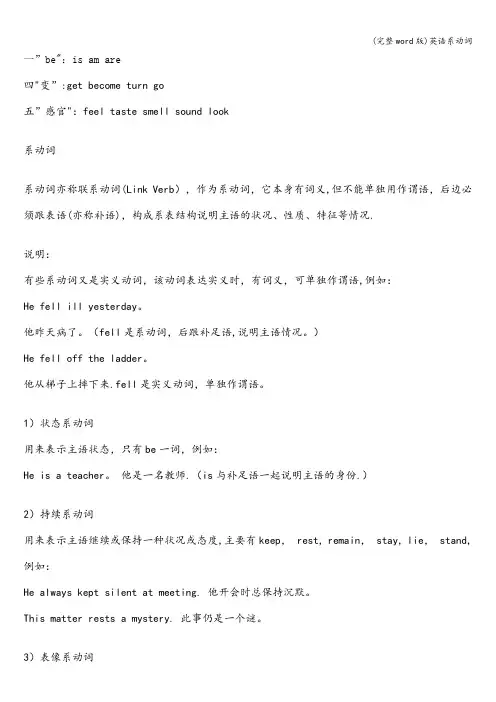
一”be":is am are四"变”:get become turn go五”感官":feel taste smell sound look系动词系动词亦称联系动词(Link Verb),作为系动词,它本身有词义,但不能单独用作谓语,后边必须跟表语(亦称补语),构成系表结构说明主语的状况、性质、特征等情况.说明:有些系动词又是实义动词,该动词表达实义时,有词义,可单独作谓语,例如:He fell ill yesterday。
他昨天病了。
(fell是系动词,后跟补足语,说明主语情况。
)He fell off the ladder。
他从梯子上摔下来.fell是实义动词,单独作谓语。
1)状态系动词用来表示主语状态,只有be一词,例如:He is a teacher。
他是一名教师.(is与补足语一起说明主语的身份.)2)持续系动词用来表示主语继续或保持一种状况或态度,主要有keep, rest, remain, stay, lie, stand, 例如:He always kept silent at meeting. 他开会时总保持沉默。
This matter rests a mystery. 此事仍是一个谜。
3)表像系动词用来表示”看起来像"这一概念,主要有seem, appear, look,例如:He looks tired。
他看起来很累。
He seems (to be) very sad。
他看起来很伤心。
4)感官系动词感官系动词主要有feel, smell, sound, taste, 例如:This kind of cloth feels very soft.这种布手感很软。
This flower smells very sweet.这朵花闻起来很香.5)变化系动词这些系动词表示主语变成什么样,变化系动词主要有become, grow, turn, fall, get, go, come, run.例如:He became mad after that. 自那之后,他疯了。
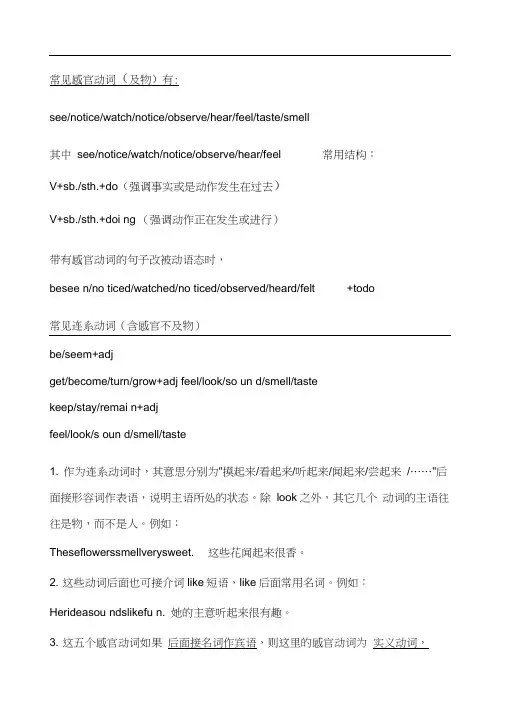
常见感官动词(及物)有:see/notice/watch/notice/observe/hear/feel/taste/smell其中see/notice/watch/notice/observe/hear/feel 常用结构:V+sb./sth.+do(强调事实或是动作发生在过去)V+sb./sth.+doi ng (强调动作正在发生或进行)带有感官动词的句子改被动语态时,besee n/no ticed/watched/no ticed/observed/heard/felt +todo常见连系动词(含感官不及物)be/seem+adjget/become/turn/grow+adj feel/look/so un d/smell/tastekeep/stay/remai n+adjfeel/look/s oun d/smell/taste1. 作为连系动词时,其意思分别为"摸起来/看起来/听起来/闻起来/尝起来/……"后面接形容词作表语,说明主语所处的状态。
除look之外,其它几个动词的主语往往是物,而不是人。
例如:Theseflowerssmellverysweet. 这些花闻起来很香。
2. 这些动词后面也可接介词like短语,like后面常用名词。
例如:Herideasou ndslikefu n. 她的主意听起来很有趣。
3. 这五个感官动词如果后面接名词作宾语,则这里的感官动词为实义动词,后面必须跟副词修饰动词。
以look 一词为例:Helookedatmehappily.(实义动词,“看”,后有宾语me用副词happily 修饰。
)Helookedhappy.(系动词,“看起来 ... ”,后接形容词作表语。
)系动词使用注意事项:◊系动词无被动语态。
Yourhandfeelscold.Thedishtastesgood.◊系动词常用在某些词组中:stayhealthy (保持健康),cometrue (实现),fallasleep (睡觉),gobad (变质)。
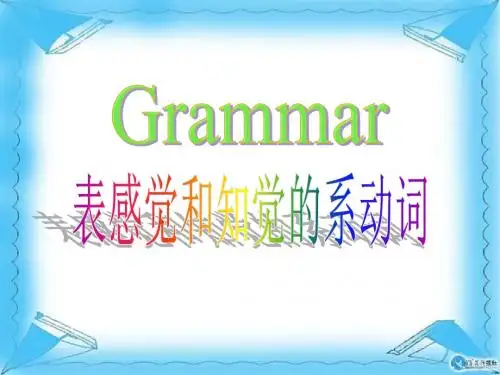
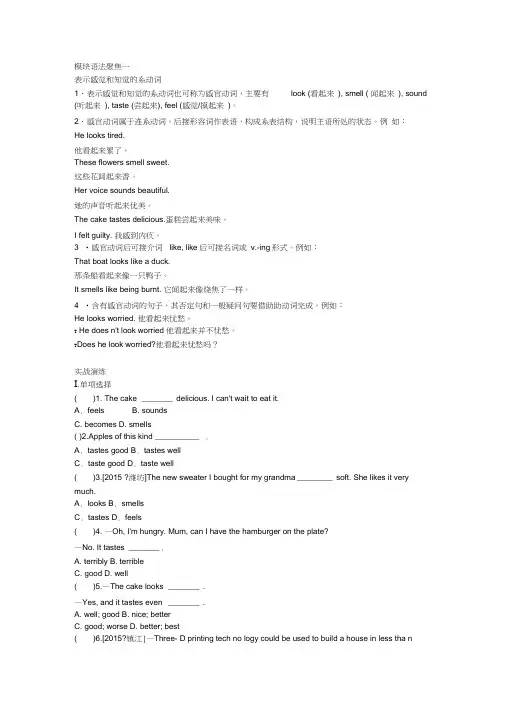
模块语法聚焦一表示感觉和知觉的系动词1.表示感觉和知觉的系动词也可称为感官动词,主要有look (看起来), smell ( 闻起来), sound (听起来), taste (尝起来), feel (感觉/摸起来)。
2.感官动词属于连系动词,后接形容词作表语,构成系表结构,说明主语所处的状态。
例如:He looks tired.他看起来累了。
These flowers smell sweet.这些花闻起来香。
Her voice sounds beautiful.她的声音听起来优美。
The cake tastes delicious.蛋糕尝起来美味。
I felt guilty. 我感到内疚。
3 •感官动词后可接介词like, like后可接名词或v.-ing形式。
例如:That boat looks like a duck.那条船看起来像一只鸭子。
It smells like being burnt. 它闻起来像烧焦了一样。
4 •含有感官动词的句子,其否定句和一般疑问句要借助助动词完成。
例如:He looks worried. 他看起来忧愁。
T He does n't look worried 他看起来并不忧愁。
T Does he look worried?他看起来忧愁吗?实战演练I.单项选择( )1. The cake _______ delicious. I can't wait to eat it.A. feelsB. soundsC. becomesD. smells( )2.Apples of this kind __________ .A. tastes goodB. tastes wellC. taste goodD. taste well( )3.[2015 ?潍坊]The new sweater I bought for my grandma ________ soft. She likes it very much.A. looksB. smellsC. tastesD. feels( )4. —Oh, I'm hungry. Mum, can I have the hamburger on the plate?—No. It tastes _______ .A. terriblyB. terribleC. goodD. well( )5.—The cake looks _______ .—Yes, and it tastes even _______ .A. well; goodB. nice; betterC. good; worseD. better; best( )6.[2015?镇江]—Three- D printing tech no logy could be used to build a house in less tha n24 hours.—It ______ amazing. It's my first time to get to know the news.A.looks B.smells C.sounds D.tastes( )7.Oh, it ___________so nice. What beautiful music it is!A.smells B.soundsC.tastes D.looks( )8.—Dinner is ready. Help yourself!—Wow! It ______ delicious. You are really good at cooking.A.looks B.soundsC.tastes D.feels( )9.—Let's go on a picnic this weekend, OK?—That sounds ______.A.great B.wellC.hardly D.terribly( )10.I like to read English in the garden because the flowers in it smell _______ .A.good B.wellC.bad D.badly( )11. —Do you like swimming in winter?—Of course. The water ______ a bit cold at first, but then I am warm and full of energy. A.tastes B.feels C.smells D.looks( )12.Mum is making dinner. It ___________ so nice!A.smells B.tastesC.feels D.sounds( )13.Good medicine for health __________ bitter to the mouth.A.feel B.tastes C.feels D.taste( )14.Some of my friends eat with their eyes. They prefer to order what _______ nice.A.feels B.smells C.looks D.tastes( )15. —Do you know the song Gangnam Style?—Of course. It ______ interesting.A.tastes B.smells C.sounds D.feelsn .根据汉语意思完成句子1.我的毛衣摸起来柔软。

感官动词一、感官动词1、感官动词(及物动词)有:see/notice/look at/watch/observe/listen to/hear/feel(Vt)/taste(Vt)/smell(Vt)2、连缀动词(含感官不及物动词) :be/get/become/feel/look/sound/smell/taste/keep/stay/seem/ appear/grow/turn/prove/remain/go/run二、具体用法:1、see, hear, smell, taste, feel,这五个动词均可作连系动词,后面接形容词作表语,说明主语所处的状态。
其意思分别为"看/听/闻/尝/摸起来……"。
除look之外,其它几个动词的主语往往是物,而不是人。
例如:These flowers smell very sweet.这些花闻起来很香。
The tomatoes feel very soft.这些西红柿摸起来很软。
2、这些动词后面也可接介词like短语,like后面常用名词。
例如:Her idea sounds like fun.她的主意听起来很有趣。
3、这五个感官动词也可作实义动词,除look(当"看起来……"讲时)只能作不及物动词外,其余四个既可作及物动词也可作不及物动词,此时作为实义动词讲时其主语一般为人。
例如:She smelt the meat.她闻了闻那块肉。
I felt in my pocket for cigarettes.我用手在口袋里摸香烟。
4、taste, smell作不及物动词时,可用于"taste / smell + of +名词"结构,意为"有……味道/气味"。
例如:The air in the room smells of earth.房间里的空气有股泥土味。
5、它们(sound除外)可以直接作名词,与have或take构成短语。
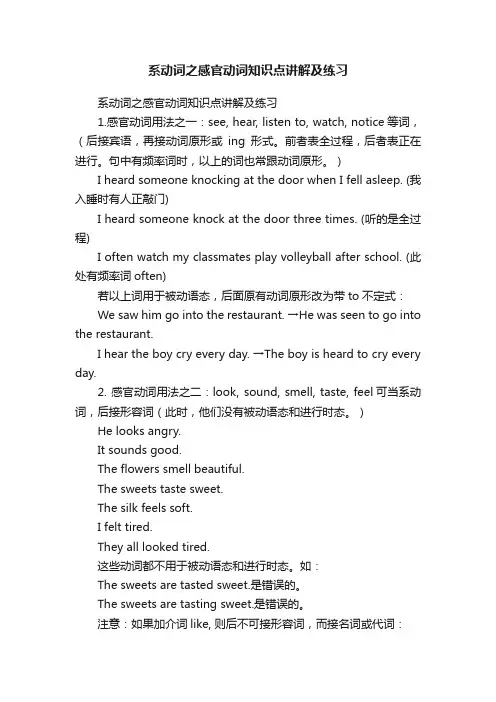
系动词之感官动词知识点讲解及练习系动词之感官动词知识点讲解及练习1.感官动词用法之一:see, hear, listen to, watch, notice等词,(后接宾语,再接动词原形或ing形式。
前者表全过程,后者表正在进行。
句中有频率词时,以上的词也常跟动词原形。
)I heard someone knocking at the door when I fell asleep. (我入睡时有人正敲门)I heard someone knock at the door three times. (听的是全过程)I often watch my classmates play volleyball after school. (此处有频率词often)若以上词用于被动语态,后面原有动词原形改为带to不定式:We saw him go into the restaurant. →He was seen to go into the restaurant.I hear the boy cry every day. →The boy is heard to cry every day.2. 感官动词用法之二:look, sound, smell, taste, feel可当系动词,后接形容词(此时,他们没有被动语态和进行时态。
)He looks angry.It sounds good.The flowers smell beautiful.The sweets taste sweet.The silk feels soft.I felt tired.They all looked tired.这些动词都不用于被动语态和进行时态。
如:The sweets are tasted sweet.是错误的。
The sweets are tasting sweet.是错误的。
注意:如果加介词like, 则后不可接形容词,而接名词或代词:He looks like his mother.That sounds like a good idea.It sounds like great fun.It smells like a flower.It tastes like salt.系动词之感官动词与be动词练习I 用be、taste、seem、look、smell、feel、sound 的适当形式填空。
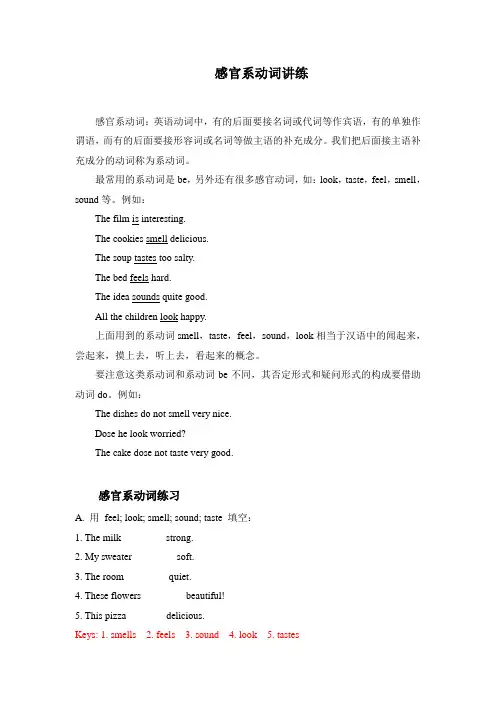
感官系动词讲练感官系动词:英语动词中,有的后面要接名词或代词等作宾语,有的单独作谓语,而有的后面要接形容词或名词等做主语的补充成分。
我们把后面接主语补充成分的动词称为系动词。
最常用的系动词是be,另外还有很多感官动词,如:look,taste,feel,smell,sound等。
例如:The film is interesting.The cookies smell delicious.The soup tastes too salty.The bed feels hard.The idea sounds quite good.All the children look happy.上面用到的系动词smell,taste,feel,sound,look相当于汉语中的闻起来,尝起来,摸上去,听上去,看起来的概念。
要注意这类系动词和系动词be不同,其否定形式和疑问形式的构成要借助动词do。
例如:The dishes do not smell very nice.Dose he look worried?The cake dose not taste very good.感官系动词练习A. 用feel; look; smell; sound; taste 填空:1. The milk ________ strong.2. My sweater ________ soft.3. The room ________ quiet.4. These flowers ________ beautiful!5. This pizza _______ delicious.Keys: 1. smells 2. feels 3. sound 4. look 5. tastesB. 首字母填空:1. The food will taste too salty if there is too much s_______ in it.2. When we talk, we should think of other’s f_________.3. Many people spend their holiday in the countryside. The enjoy the f ______ air there .4. I want some more cookie. It t________ really good.Keys: 1. salt 2. feelings 3. fresh 4. tastesC. 完成句子:1. 丝绸摸起来很柔软。
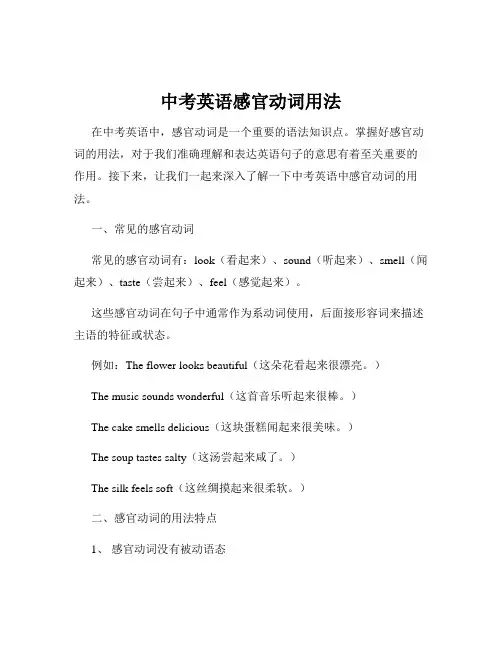
中考英语感官动词用法在中考英语中,感官动词是一个重要的语法知识点。
掌握好感官动词的用法,对于我们准确理解和表达英语句子的意思有着至关重要的作用。
接下来,让我们一起来深入了解一下中考英语中感官动词的用法。
一、常见的感官动词常见的感官动词有:look(看起来)、sound(听起来)、smell(闻起来)、taste(尝起来)、feel(感觉起来)。
这些感官动词在句子中通常作为系动词使用,后面接形容词来描述主语的特征或状态。
例如:The flower looks beautiful(这朵花看起来很漂亮。
)The music sounds wonderful(这首音乐听起来很棒。
)The cake smells delicious(这块蛋糕闻起来很美味。
)The soup tastes salty(这汤尝起来咸了。
)The silk feels soft(这丝绸摸起来很柔软。
)二、感官动词的用法特点1、感官动词没有被动语态因为感官动词所表达的是人的主观感受,不是被动接受的动作,所以没有被动语态。
例如:不能说“The flower is looked beautiful by me” 而只能说“The flower looks beautiful”2、感官动词后接形容词,而不是副词这是感官动词的一个重要特点,很多同学容易在这里犯错。
比如:要说“He looks happy” 而不是“He looks happily”3、感官动词+like +名词表示“看起来像”例如:She looks like her mother(她看起来像她的母亲。
)三、感官动词的句型结构1、主语+感官动词+形容词这是最基本的句型结构,表示主语给人的某种感觉。
例如:The dress feels smooth(这件连衣裙摸起来很光滑。
)2、主语+感官动词+ like +名词/代词这个句型表示“主语看起来像”例如:The cloud looks like a dog(那朵云看起来像一只狗。

初中连系动词综合分析(全
1. be动词:
- am、is、are用来表示现在进行时态。
- was、were用来表示过去进行时态。
- am、is、are、 was、were也可以用来表示一般现在时态、一般过去时态。
例句:
- He is playing soccer.(他正在踢足球。
)
- They were dancing last night.(他们昨晚在跳舞。
)
- I am a student.(我是一名学生。
)
2.感官动词:
感官动词用来描述人们的感觉或感知。
例句:
- The flowers look beautiful.(花看起来很漂亮。
)
- The cake tastes delicious.(蛋糕尝起来很美味。
)
- The soup smells good.(汤闻起来很香。
)
3.状态动词:
状态动词用来描述事物的状态或变化。
例句:
- She seems happy.(她似乎很开心。
)
- The flowers have grown tall.(花长高了。
)
总体来说,初中生需要学习这些连系动词及其用法,以能够准确地表达和描述事物的状态、变化和感受。
通过实际的练习和运用,可以逐渐提高对这些连系动词的理解和运用能力。
感官动词系动词文稿归稿存档编号:[KKUY-KKIO69-OTM243-OLUI129-G00I-FDQS58-常见感官动词(及物)有:see/notice/watch/notice/observe/hear/feel/taste/smell其中see/notice/watch/notice/observe/hear/feel常用结构:V+sb./sth.+do(强调事实或是动作发生在过去)V+sb./sth.+doing(强调动作正在发生或进行)带有感官动词的句子改被动语态时,beseen/noticed/watched/noticed/observed/heard/felt+todo常见连系动词(含感官不及物)be/seem+adjget/become/turn/grow+adjfeel/look/sound/smell/tastekeep/stay/remain+adj1.作为连系动词时,其意思分别为"摸起来/看起来/听起来/闻起来/尝起来/……"后面接形容词作表语,说明主语所处的状态。
除look之外,其它几个动词的主语往往是物,而不是人。
例如:Theseflowerssmellverysweet.这些花闻起来很香。
2.这些动词后面也可接介词like短语,like后面常用名词。
例如:Herideasoundslikefun.她的主意听起来很有趣。
3.这五个感官动词如果后面接名词作宾语,则这里的感官动词为实义动词,后面必须跟副词修饰动词。
以look一词为例:Helookedatmehappily.(实义动词,“看”,后有宾语me,用副词happily修饰。
)Helookedhappy.(系动词,“看起来……”,后接形容词作表语。
)系动词使用注意事项:◇系动词无被动语态。
Yourhandfeelscold.Thedishtastesgood.◇系动词常用在某些词组中:stayhealthy(保持健康),cometrue (实现),fallasleep(睡觉),gobad(变质)。
常见感官动词(及物)有:see/notice/watch/notice/observe/hear/feel/taste/smell其中see/notice/watch/notice/observe/hear/feel 常用结构:V + sb./sth. + do (强调事实或是动作发生在过去)V + sb./sth. + doing (强调动作正在发生或进行)带有感官动词的句子改被动语态时,be seen/noticed/watched/noticed/observed/heard/felt + to do常见连系动词(含感官不及物)be/seem + adjget/become/turn/grow + adjfeel/look/sound/smell/tastekeep /stay /remain + adj1.作为连系动词时,其意思分别为"摸起来/看起来/听起来/闻起来/尝起来/……"后面接形容词作表语,说明主语所处的状态。
除look 之外,其它几个动词的主语往往是物,而不是人。
例如:These flowers smell very sweet.这些花闻起来很香。
2.这些动词后面也可接介词like短语,like后面常用名词。
例如:Her idea sounds like fun.她的主意听起来很有趣。
3. 这五个感官动词如果后面接名词作宾语,则这里的感官动词为实义动词,后面必须跟副词修饰动词。
以look一词为例:He looked at me happily. (实义动词,“看”,后有宾语me,用副词happily修饰。
)He looked happy. (系动词,“看起来……”,后接形容词作表语。
)系动词使用注意事项:◇系动词无被动语态。
Your hand feels cold.The dish tastes good.◇系动词常用在某些词组中:stay healthy(保持健康), come true(实现), fall asleep(睡觉), go bad(变质)。
感官动词系动词精编
W O R D版
IBM system office room 【A0816H-A0912AAAHH-GX8Q8-GNTHHJ8】
常见感官动词(及物)有:
see/notice/watch/notice/observe/hear/feel/taste/smell
其中see/notice/watch/notice/observe/hear/feel 常用结构:
V + sb./sth. + do (强调事实或是动作发生在过去)
V + sb./sth. + doing (强调动作正在发生或进行)
带有感官动词的句子改被动语态时,
be seen/noticed/watched/noticed/observed/heard/felt + to do
常见连系动词(含感官不及物)
be/seem + adj
get/become/turn/grow + adj
feel/look/sound/smell/taste
keep /stay /remain + adj
1.作为连系动词时,其意思分别为"摸起来/看起来/听起来/闻起来/尝起来/……"后面接形容词作表语,说明主语所处的状态。
除look之外,其它几个动词的主语往往是物,而不是人。
例如:
These flowers smell very sweet.这些花闻起来很香。
2.这些动词后面也可接介词like短语,like后面常用名词。
例如:
Her idea sounds like fun.她的主意听起来很有趣。
3. 这五个感官动词如果后面接名词作宾语,则这里的感官动词为实义动词,后面必须跟副
词修饰动词。
以look一词为例:
He looked at me happily. (实义动词,“看”,后有宾语me,用副词happily修饰。
)
He looked happy. (系动词,“看起来……”,后接形容词作表语。
)
系动词使用注意事项:
◇系动词无被动语态。
Your hand feels cold.
The dish tastes good.
◇系动词常用在某些词组中:stay healthy(保持健康), come true(实现), fall asleep (睡觉), go bad(变质)。
单项选择:
( ) 1. ----Which of those radios sounds ________
----The smallest one. (09无锡)
A. good
B. well
C. better
D. best
( ) 2. Grandma, you must feel ________ after cleaning the house. Let’s take a rest. (09淮安) A. tired B. well C. good D. angry
( ) 3. The music in the supermarket sounded so _____ that I wanted to leave at once. (09常州)
A. soft
B. wonderful
C. friendly
D. noisy
( ) 4. ----Do you like the film
----No, it’s ________. It makes me want to sleep.
A. boring
B. interesting
C. sleepy
D. noisy
( ) 5. ----What is Mum cooking in the kitchen (09扬州)
----Fish, I guess. How nice it _________!
A. looks
B. sounds
C. tastes
D. smells
( ) 6. ----Have you ever heard the song Welcome to Beijing (09泰州)
----Yes, it _______ nice.
A. hears
B. sounds
C. looks
D. listens
( ) 7. I've got nothing to do. I'm ________. (08徐州)
A.bored
B. interested
C. excited
D. frightened
( ) 8.----How much money did you pay for the drink
----None. It was ________. (08扬州)
A.easy
B. free
C. cheap
D. expensive
( ) 9. The girl's voice sounds ________. Maybe she can become a good singer when she grows up. (08淮安)
A. sweet
B. sweetly
C. beautifully
D. beauty
( ) 10. In the Science Museum, the children felt _____ to see so many ______ things. (08镇江)
A.surprised; amazed
B. surprising; amazing
C. surprising; amazed
D. surprised; amazing
词汇:
1.Don't get _________(patient) about your personal trouble. (08无锡)
2.He seemed __________(friend) at first, but now I've got to know him and I realize he's warmand kind. (08徐州)
3.The weather today becomes even ________(bad). Why not take a raincoat with you (08宿迁)
4.If someone doesn't show good manners to others, he or she is __________(polite). (08宿迁)
5. If you don't see the doctor at once, you'll get even __________(ill) later on. (08泰州)
6. I like listening to light music. It can make me feel _______(relax) (09镇江)
7. This question is very ________(容易的). Every one of us can answer it. (09宿迁)
8. The illness can make you feel tired and _________(not strong) (09宿迁)
9. The mother looked _______(angry) at her naughty daughter. (09宿迁)。